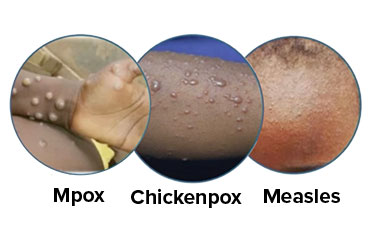Originally published by our sister publication Infectious Disease Special Edition
By Marie Rosenthal, MS
The mpox outbreak in the Democratic Republic of Congo has spilled over into Uganda, which borders the DRC, according to reports at CROI 2025, which is ongoing in San Francisco (abstract 191). Surveillance has found co-circulating viruses, particularly varicella-zoster virus, with one person coming down with coinfections. That person died, according to Nicholas Bbosa, PhD, an assistant professor at the London School of Hygiene & Tropical Medicine (LSHTM) and a molecular virologist by training and scientist at the Medical Research Council/Uganda Virus Research Institute & LSHTM Uganda Research Unit.

“Uganda’s mpox outbreak is closely related to the recent clade 1b mpox outbreaks in the Democratic Republic of Congo. We are able to confirm an impact from varicella-zoster virus coinfection and co-circulation,” Dr. Bbosa said. Other African countries—the DRC in 2020 and Burundi in 2024—saw similar findings. Tightening the case definition and warning healthcare professionals about the differential diagnoses might prevent misdiagnoses, according to Dr. Bbosa.
Because Uganda borders the DRC, the country heightened surveillance for mpox after the DRC announced its outbreak to mitigate any cross-border spillover, Dr. Bbosa said.
“Last year, there were reports of an increase in the number of cases in the DRC, and we decided to enhance surveillance at the border with the DRC in May of last year. In July of 2024, we are able to identify the first two cases of human monkeypox,” Dr. Bbosa said.
The cases among two females were detected by real-time polymerase chain reaction (rtPCR) and confirmed by genomic sequencing. One case was a 37-year-old woman who frequently traveled to the DRC, while the other was a 22-year-old pregnant woman who sought prenatal care at Bwera General Hospital, in the Kasese District (Emerg Infect Dis 2025;31[1]:144-148).
“Phylogenetic analysis on 73 samples showed that the mpox sequences were closely genetically related to clade 1b sequences from the DRC, and this was the case again for the index cases that were identified in July 2024. So this led us to believe that the mpox outbreak was closely related to mpox outbreaks in the Democratic Republic of Congo,” Dr. Bbosa explained.
By August, 12 African countries had found mpox cases, including Uganda, according to the WHO. So far, there have been 3,800 cases confirmed in Uganda and 30 deaths. Males account for about 57% of the cases, and most of these are between 18 to 29 years of age.
Clinically suspected cases are sent to laboratories where viral DNA extraction and rtPCR are done. Any that are positive are sequenced. For this study, public health officials genotyped 73 confirmed mpox samples that were collected between July and December 2024. However, “several individuals that presented with signs and symptoms similar to mpox had tested negative on real-time PCR,” he said.
“So we were curious, and we went ahead and performed differential diagnosis on a total of 127 mpox-negative specimens,” he said. Results of the differential testing of the mpox-negative cases showed that varicella-zoster virus, which is a common cause for chickenpox and shingles, was detected in 83% of the samples. In addition, they identified other viruses in the samples, including measles and coxsackievirus.
“We also noted that for the varicella-zoster virus sequences, some of these were closely related to others that have been identified elsewhere in other countries in West Africa, like Ghana and Nigeria,” Dr. Bbosa said.
They also detected an mpox–varicella coinfected case. “This is an individual who was confirmed to have mpox but eventually passed away,” he said.
The skin lesions could be misidentified by practitioners, he warned, especially if the case definition for mpox is too broad and not well defined.
He said they recommended a need to improve the case definition to reduce misidentification. “This information has been shared by the Uganda Ministry of Health to help improve the case definition. And the recommendation also is that differential diagnoses should be considered as part of routine testing for other emerging and reemerging diseases during outbreaks,” Dr. Bbosa said.




